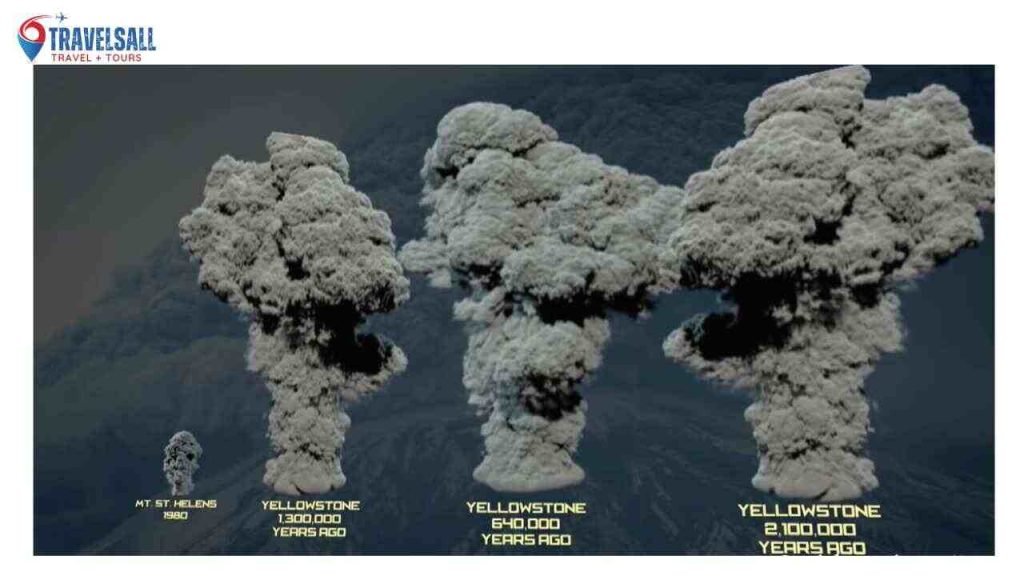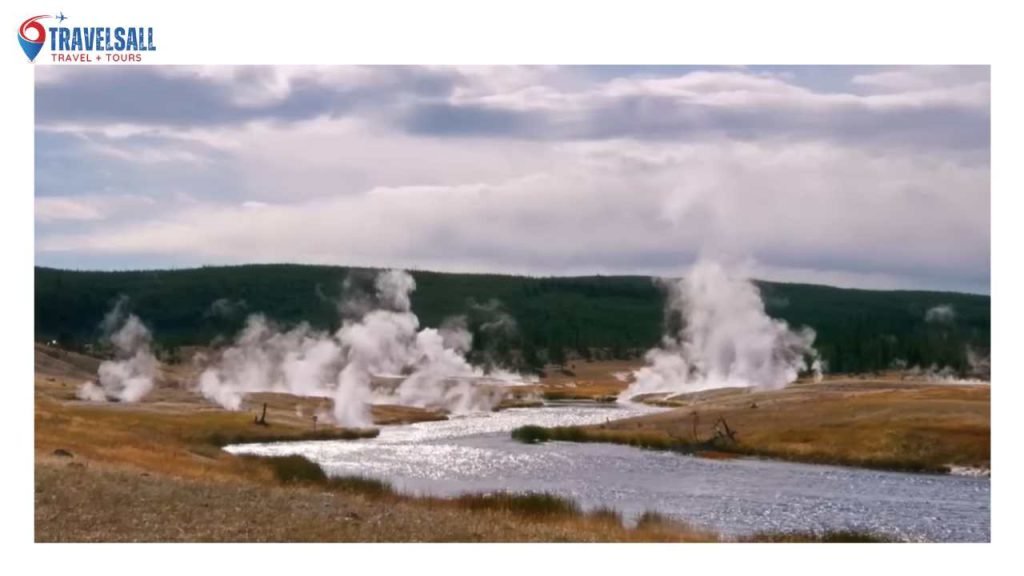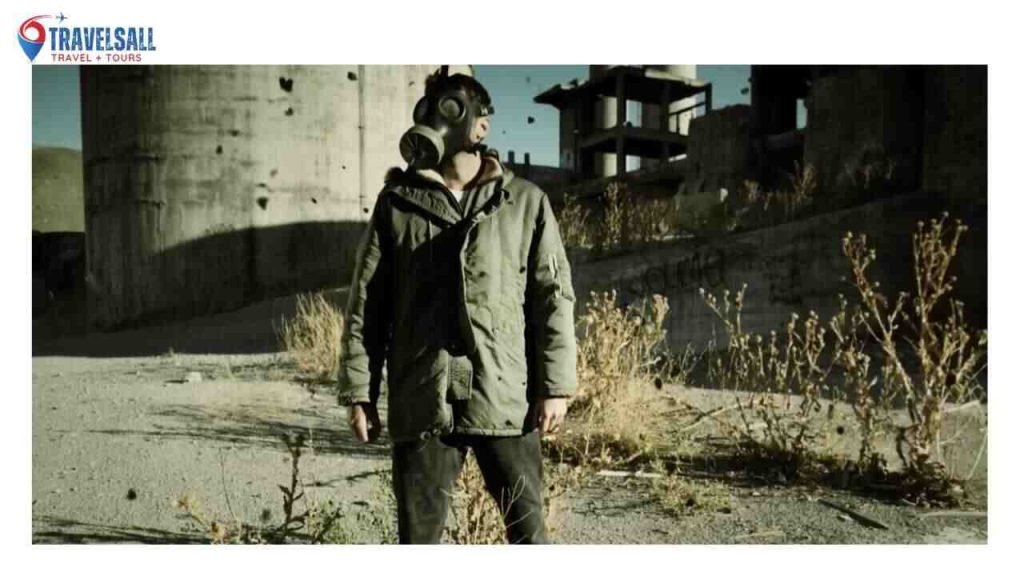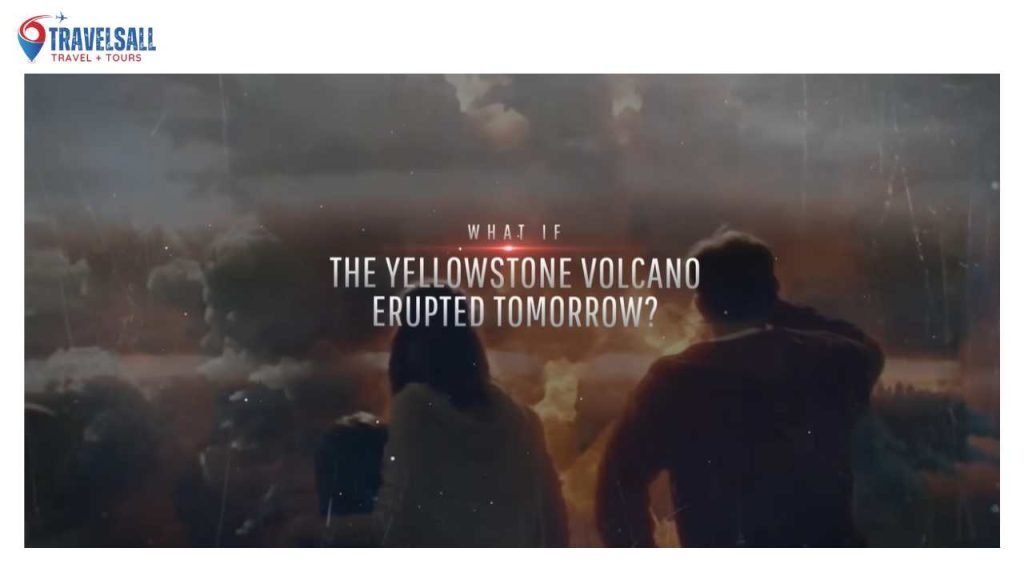If Yellowstone National Park erupted, it could trigger widespread destruction and a global climate crisis. This supervolcano’s explosion would have catastrophic repercussions.
Yellowstone National Park is a breathtaking reserve that sits atop a massive supervolcano.
The potential eruption of Yellowstone has been a topic of much speculation due to the immense power that lurks beneath its serene landscape.
Home to geothermal wonders like geysers and hot springs, this tranquil facade masks one of the most potentially explosive sites on Earth.
An eruption, although considered rare on a human timescale, poses significant threats. Pyroclastic flows, ashfall, and climate/agricultural impacts would devastate immediately and have far-reaching consequences.
Acknowledging the risk, scientists continuously monitor volcanic activity, making it a subject of intense study and concern for global communities.
Learning about Yellowstone’s volcanic nature is essential for preparedness and mitigation strategies in the unlikely event of such an eruption.
Table of Contents
ToggleYellowstone’s Sleeping Giant

The very ground of Yellowstone National Park holds a secret of titanic proportions. Few are unaware of the tranquil beauty that Yellowstone preserves.
Beneath this tranquil exterior, however, lies a force so immense it’s hard to comprehend.
Known as the Yellowstone Supervolcano, this slumbering behemoth has the potential to change life on Earth as we know it.
The Supervolcano Beneath The Park
Hidden beneath Yellowstone’s geysers and hot springs is a magma chamber of colossal size. This underground reservoir of molten rock spans approximately 40 miles across.
Scientists classify it as a supervolcano due to its capability to produce an eruption of more than 240 cubic miles of magma.
Supervolcanic eruptions are thousands of times more powerful than average volcanic blasts. They can spew massive amounts of ash and gases into the atmosphere, affecting global climate.
The last full-scale eruption of the Yellowstone Supervolcano occurred roughly 640,000 years ago. It formed the Yellowstone Caldera, the vast, crater-like basin that now encompasses much of the park.
Historical Eruptions And Patterns
- 2.1 million years ago: First Yellowstone eruption.
- 1.3 million years ago: Second major event.
- 640,000 years ago: Most recent full-scale eruption.
Between these major catastrophes, the park has witnessed smaller eruptions and frequent thermal activity.
Scientists study the patterns of past eruptions to predict future activity. While the intervals between major eruptions seem irregular, they help in understanding volcanic behavior.
Potential Triggers And Signs

Imagine Yellowstone National Park’s supervolcano awakening. The possibility may seem remote, but it’s crucial to understand the triggers and signs that could herald such an eruption.
Scientists study Yellowstone closely. They look for clues that could signal a change in the volcano’s behavior. Knowing these signs helps with early warnings and disaster preparedness.
Indicators Of Imminent Eruption
What hints at the volcano waking up? Key indicators provide critical insights. A marked increase in ground deformation can imply magma moving towards the surface.
Magma movements could suggest pressure is building beneath the park. Gases escape from magma and reach the surface, changing the content of gases near the geysers and hot springs.
Also, an uptick in geyser activity or temperature changes in hydrothermal systems are noteworthy signs.
- Heightened ground deformation detected by GPS and InSAR
- Shifts in hydrothermal activity and geyser behavior
- Gas emissions with increased levels of carbon dioxide and sulfur
Role Of Seismic Activity
Seismic activity plays a pivotal role in signaling a potential eruption. Earthquakes shake the park often.
Yet, a pattern of frequent and high-magnitude earthquakes can indicate magma movement. The ground vibrates as magma cracks rocks and pushes upwards.
| Seismic Indicator | Description |
|---|---|
| Earthquake Swarms | Unusual clusters of minor tremors over short periods |
| Harmonic Tremors | Long-duration vibrations signaling magma motion |
| Magnitude Frequency | Increasing with proximity to potential eruption |
Seismic monitoring networks around Yellowstone are always on alert. They track these patterns to gauge the risk of an explosive event.
Immediate Aftermath Of An Eruption
The moment Yellowstone National Park erupts, a cascade of catastrophic events will follow. Nature’s fury would be unleashed, painting a daunting picture of the immediate aftermath.
Knowing the immediate consequences sheds light on the vast scale of potential devastation.
Economic And Human Toll
The eruption of Yellowstone would lead to unimaginable losses both in human lives and economically. The region would witness:
- Massive evacuation efforts, straining resources.
- Air travel disruption across North America, affecting global flights.
- Agricultural damage, with ash destroying crops and livestock.
- Infrastructure collapse, including buildings, roads, and utilities.
The financial impact is hard to fathom, running into billions of dollars due to:
- Emergency services stretch, requiring vast funding.
- Recovery and rebuilding costs for affected areas.
- Healthcare costs skyrocket due to injuries and respiratory issues from ash.
- Insurance claims surge, leading to economic strain on insurers and policyholders.
Impact On The Landscape
The eruption’s impact on the landscape would be both immediate and severe:
- Ash blankets the land, smothering plants and polluting waterways.
- Lava flows reshape geography, creating new landscapes.
- Pyroclastic flows devastate surrounding regions.
- Earthquakes and ground deformation alter the region’s topography.
These changes lead to:
- Habitat loss for countless wildlife species.
- Altered river courses, impacting ecosystems and human settlements.
- Changed climate patterns, with a “volcanic winter” likely to ensue.
- Long-term ecological recovery takes decades or longer.
Ash Cloud Catastrophe

Imagine the sky turning dark as day turns to night. This could happen if Yellowstone erupted. An immense cloud of ash would cover the sky. This is the ‘Ash Cloud Catastrophe’.
Spread Of Volcanic Ash
The eruption at Yellowstone would spew ash for thousands of miles. This volcanic ash would reach far beyond park boundaries.
Fine ash particles would blanket the land. Cities, towns, and ecosystems could suffer under a heavy layer of ash.
- Visibility would drop sharply, making driving hazardous.
- Daylight diminishes, affecting plant growth and animal behavior.
- Infrastructure burdened by ash weight, leading to collapses.
Effects On Air Travel
Air travel faces immediate disruption. Ash clouds can damage aircraft engines. Planes must avoid ash-filled airspace. This means:
- Canceled flights across the country and, possibly, the globe.
- Diverted flight paths cause delays and congestion.
- Stranded passengers due to flight cancellations and airport shutdowns.
Airports may close, affecting the economy significantly. The tourist industry in particular could see major financial losses.
Climate Shifts From Eruption
The thought of Yellowstone National Park erupting is a daunting one. Such an event would lead to significant changes in our climate.
It’s crucial to explore how this could affect global temperatures and agriculture.
Global Temperature Changes
An eruption at Yellowstone could thrust ash and gases high into the atmosphere. These particles would act like a giant sunshade.
They would block sunlight from reaching the Earth’s surface. This effect is known as volcanic winter.
- Short-term cooling: The globe might experience a decrease in average temperatures.
- Years of impact: The cooling effect could last for years or even decades.
- Sudden weather pattern shifts could become frequent.
The severity of temperature drops would depend on the size of the eruption. Historically, large volcanic eruptions have led to noticeable temperature decreases globally.
Agricultural Repercussions
Cold weather can greatly impact crop yields. A significant dip in global temperatures poses a real threat to food supplies.
| Crops | Possible Effects |
|---|---|
| Grains (wheat, corn) | Delayed planting, stunted growth, reduced yields |
| Fruits and vegetables | Poor pollination, frost damage, loss of plants |
| Livestock | Shortage of feed, increased mortality rates |
Not just crops, but livestock farming would also bear the brunt of the resultant cool climate. Food security becomes a critical issue in such scenarios, making global hunger a pressing concern.
Human Response And Survival

The thought of Yellowstone National Park erupting chills our bones. It sits atop a massive supervolcano. If an eruption occurs, understanding human response and survival is crucial.
This knowledge could mean the difference between chaos and order, hopelessness and survival. Below are measures and strategies pivotal for safety.
Evacuation Procedures
Immediate action saves lives. Here are essential steps for a swift evacuation:
- Emergency Alerts: Stay tuned to local news and NOAA radios.
- Route Planning: Know multiple escape paths to avoid congested roads.
- Essential Supplies: Pack a bag with food, water, medications, and clothes.
- Communication Plan: Arrange a meeting point for family and friends.
Adhering to government evacuation orders is non-negotiable.
Long-term Survival Strategies
Surviving long-term requires preparation and adaptability. Here are strategies to consider:
| Strategy | Details |
|---|---|
| Shelter | Find or construct a sturdy shelter to protect from ashfall and weather. |
| Water | Secure a clean water supply; volcanic ash can contaminate water sources. |
| Food Storage | Stockpile non-perishable food items, and learn food preservation techniques. |
| Healthcare | Maintain a first-aid kit and knowledge of basic medical care. |
| Community | Collaborate with others for resource sharing and emotional support. |
Inhabitants must be ready for long-term lifestyle changes. Reliance on local resources and self-sufficiency will be key for enduring the aftermath.
Ecosystems At Risk
If Yellowstone National Park erupted, it would pose a severe risk to its ecosystems. This iconic landscape, known for its abundant wildlife and geological features, could face catastrophic changes.
Such an event would disrupt the intricate web of life that includes plants, animals, and microorganisms.
Species Affected
The eruption would threaten the survival of many species. Here’s an overview of the impact on wildlife:
- Bison: These majestic animals, symbolic of the park, could suffer loss of grazing lands.
- Grizzly Bears: Critical to the ecosystem, their food sources might vanish.
- Wolves: Packs in Yellowstone rely on other animals for food, which could become scarce.
- Birds: Ash fall would affect bird populations, altering migration patterns.
- Fish: Ash and temperature changes in water systems might lead to fish kills.
- Plants: Vital to the food chain, vegetation would face a struggle with layers of ash.
- Microorganisms: Tiny life forms, essential for decomposing and soil fertility, would be heavily impacted.
Recovery Of Flora And Fauna
Post-eruption, recovery would be a slow process.
| Year Range | Recovery Expected |
|---|---|
| 1-3 Years | Initial survivors re-emerge, some plants re-root from ashes. |
| 3-20 Years | Secondary succession begins, some animals return. |
| 20+ Years | The new ecosystem stabilizes, and diversity gradually increases. |
While some flora and fauna possess resilience, humans would need to aid recovery. Assessment of habitat loss and reintroduction of species would be necessary.
It would require a collaboration of scientists, conservationists, and policy-makers to facilitate healing in these ecosystems.
Economic Repercussions
The very thought of Yellowstone National Park erupting invokes a sense of awe and worry. Such an event would have far-reaching economic consequences, affecting not just the local area but extending globally.
As we peel back the layers of potential impact, local costs of reconstruction and the shockwave through the global economy become starkly apparent.
Costs Of Reconstruction
Rebuilding after a massive volcanic eruption like Yellowstone would be a colossal challenge.
With infrastructure decimated, the immediate focus would be on essential recovery efforts. Here’s a snapshot of the potential expenditure:
- Repairing damaged roads and bridges
- Restoring communication networks
- Reconstructing homes and businesses
- Dealing with environmental cleanup
| Area Affected | Reconstruction Cost |
|---|---|
| Infrastructure | $Billions |
| Housing | $Billions |
| Business | $Billions |
Impact On The Global Economy
An eruption at Yellowstone would have a ripple effect on the global economy. Here are some aspects to consider:
- Disruption of air travel due to ash clouds
- Decreased agricultural production leading to food shortages
- Changes in climate impacting energy demand
- Increased insurance claims pressuring financial markets
Supply chains around the world would face interruptions. Countries interconnected through trade would feel the shock.
Stock markets might dip as investors react to the uncertainty. The tourism industry would suffer losses as well, given Yellowstone’s international attraction.
In essence, the economic tremors from such a cataclysmic event could lead to a recession felt worldwide.
Learning From The Unthinkable
The thought of Yellowstone National Park erupting sends chills down the spine of anyone familiar with its vast beauty.
Dubbed a supervolcano due to the colossal size of its magma chamber, Yellowstone has the potential to change life on Earth.
Preparing for a volcanic eruption requires both short-term response plans and innovative, long-term strategies based on research.
Learning from the unthinkable prepares humanity for such extraordinary events.
Advancements In Volcanic Research
The last few decades have seen tremendous progress in volcanic research. By unlocking the secrets of these geological giants, scientists better understand the precursor signs that signal an eruption.
Monitoring has become more precise with seismic activity, ground deformation, and gas emission all tracked in real-time.
- Seismic Monitoring: A network of seismographs tracks even the smallest tremors.
- GPS Technology: This tracks the swelling of the Earth’s surface.
- Satellite Imagery: It provides visual evidence of changes in thermal activity.
These technological advances pave the way for early warning systems that could save countless lives in the event of an eruption.
Improving Disaster Preparedness
Disaster preparedness has evolved significantly, turning lessons learned into life-saving protocols.
Emergency managers and researchers develop volcanic hazard evacuation plans, supply chains, and public education programs collaboratively.
- Evacuation Routes: Marked and practiced by local communities.
- Stockpiling Necessities: Strategic reserves of food, water, and medical supplies.
- Communication Systems: Robust, fail-safe communication channels for alerts and updates.
Integrating these plans into disaster management could mitigate the impact of a Yellowstone eruption, enabling a structured response.
Frequently Asked Questions For What If Yellowstone National Park Erupted
Would We Survive If Yellowstone Erupted?
Surviving a Yellowstone eruption depends on various factors, including the eruption’s size and your proximity to it. While local areas could face devastation, humanity globally would likely endure, enduring potential climatic impact and agricultural disruptions.
What States Would Be Safe If Yellowstone Erupts?
No states are entirely safe if Yellowstone erupts; ash fallout and climate effects can reach across the United States. However, regions farther east may experience fewer immediate impacts than those closer to the volcano.
What Happened When Yellowstone Erupted?
Yellowstone’s volcanic eruption caused massive ash ejection, drastically affecting climate and ecosystems. It led to widespread destruction and altered global weather patterns, impacting agriculture and health.
What Would Happen To Colorado If Yellowstone Erupted?
An eruption at Yellowstone would cover Colorado in volcanic ash. Air quality would drastically worsen, disrupting transportation and agriculture. Health hazards from ash inhalation could significantly affect residents.
Conclusion
The prospect of Yellowstone erupting is a powerful reminder of nature’s unpredictability. While we can’t predict exactly when or if a major event will occur, preparedness and awareness are vital.
Acknowledging the potential risks helps us appreciate and respect the forces beneath Yellowstone and the importance of monitoring our planet’s geological activity for future safety.



